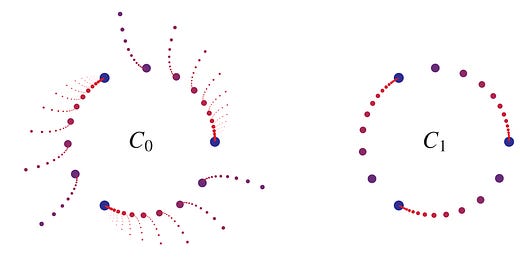The continuum hypothesis
Is there any infinity strictly between the infinity of the natural numbers ℕ and the infinity of the real numbers ℝ?
The infinity of the set of real numbers ℝ is uncountable—it is strictly larger than the infinity of the set of natural numbers ℕ.
Question. Is there any infinity strictly between them?
This innocent and very natural question, asked by Cantor in the early days of set theory shortly after proving the uncountability of ℝ, was the origin of a sweeping mathematical research effort spanning the twentieth century. The continuum problem, as the question became known, had become one of the most prominent open questions in mathematics, one leading furthermore to vibrant philosophical disputes concerning fundamental issues in the foundations of mathematics and the nature of mathematical truth. Let me relate the story here in this chapter.
Cantor himself had become truly obsessed with the question, although it staunchly resisted all attempts at resolution. He formulated his ideas and expectations for what the answer might be with the continuum hypothesis, the principle asserting that indeed there are no such intermediate infinities.
Continuum hypothesis. There is no infinity strictly between ℕ and ℝ.
But Cantor had no proof. He struggled with the question his entire life, at times searching for counterexamples, but mostly striving to establish the truth of the continuum hypothesis. He observed in many instances that particular sets conform with the continuum hypothesis—indeed, in every case in which he was able to determine the outcome, the result conformed with the continuum hypothesis—but he lacked a general proof that this would always be the case.
Cantor laid out a strategic program for proving the continuum hypothesis—he proposed to establish the continuum hypothesis first for simple sets and then proceed to sets of higher logical complexity. He successfully carried out the beginning steps of this program, but alas, was unable to carry it further. Regrettably, he died without learning an answer. And similarly for his mathematical contemporaries, which included many prominent distinguished mathematicians—none at the time could find a resolution of the continuum problem.
The eminent mathematician David Hilbert had placed the continuum problem at the very top of a list of 23 open mathematical problems that he had announced at the 1900 International Congress of Mathematicians, a list which went on to become extremely influential, inspiring numerous huge mathematical research programs. These were considered the most important mathematical questions of that time—several of the problems remain unsolved to this day—and Cantor's continuum problem was at the very top of the list. Thus the continuum problem was arguably the most prominent open question in mathematics.
What is your view? Can you produce a set realizing an intermediate size of infinity between ℕ and ℝ? Can you prove that there is no such intermediate infinity?
Interlude
Ubiquitous equinumerosity
Let us gain some familiarity and context for the continuum problem by exploring the cardinalities of various naturally arising sets.
Keep reading with a 7-day free trial
Subscribe to Infinitely More to keep reading this post and get 7 days of free access to the full post archives.



